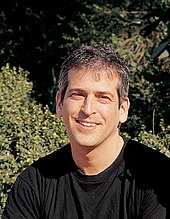Uri Alon
Uri Alon (* 1969 ) is an Israeli physicist and professor of systems biology at the Weizmann Institute .
Alon studied at the Hebrew University , where he received his PhD in theoretical physics with David Mukamel. He was a post-graduate student at Princeton University . He then went to the Weizmann Institute, where he became an associate professor in 2004 and a professor in 2008.
He dealt with gene regulation networks in E. coli and introduced the term network motif during their analysis in 2002. They act, for example, as generators of temporal patterns (oscillators), filters, pulse generators, response amplifiers and examples are feed forward loops (FFL), single input modules (SIM), negative autoregulation (NAR, and positive PAR). They are also found in other biological networks (such as in the nervous system). He also studied the evolution of biological networks (experimentally and theoretically) in his laboratory.
In his laboratory, he built a library of over 2000 E. coli strains in which fluorescent proteins serve as indicators of the promoters in E. coli gene expression . They are also working on methods to simultaneously observe hundreds of proteins in living human cells and their dynamics.
In 2007 he became a member of the European Molecular Biology Organization (EMBO). In 2004 he received the Overton Prize of the International Society for Computational Biology, in 2001 the EMBO Young Investigator Award, in 2003 the Morris L. Levinson Award in Biology and in 2014 the HFSP Nakasone Award . In 2000 he was a Moore Fellow at Caltech .
Fonts
- An introduction to systems biology: design principles of biological circuits , Boca Raton: Chapman & Hall / CRC 2007
Web links
Individual evidence
- ^ R. Milo, S. Shen-Orr, S. Itzkovitz, N. Kashtan, D. Chklovskii, U. Alon: Network motifs: simple building blocks of complex networks , Science 298, 2002, pp. 824-827
- ↑ S. Shen-Orr, R. Milo, S. Mangan, U. Alon: Network motifs in the transcriptional regulation network of Escherichia coli , Nature Genetics 31, 2002 ,: 64-68
| personal data | |
|---|---|
| SURNAME | Alon, Uri |
| BRIEF DESCRIPTION | Israeli physicist and systems biologist |
| DATE OF BIRTH | 1969 |
